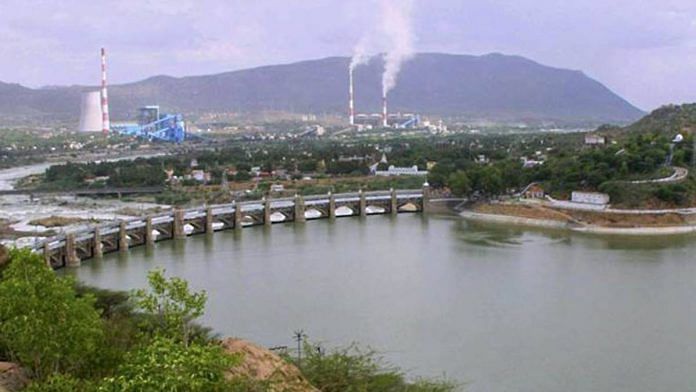Bengaluru: The Karnataka government is likely to propose in court a distress formula for sharing of Cauvery river water with Tamil Nadu during drought years, as deficit rains threaten to intensify tensions with the neighbouring state, ThePrint has learnt.
The Cauvery river’s basin originates in Karnataka and flows through Tamil Nadu and Puducherry before entering the Bay of Bengal.
Karnataka and Tamil Nadu have locked horns over the quantum of Cauvery water released to the latter, as deficient rains this monsoon have led to lower inflows in most reservoirs in the basin and fueled fears of severe shortage of water for drinking and irrigation in the coming months.
The matter is currently in the Supreme Court after Tamil Nadu approached it earlier this month demanding that it be given its fair share of Cauvery water.
“We will argue that Tamil Nadu’s application is not maintainable and also state that there is no distress formula to account for deficiency in rain while releasing water,” a person in the Congress-led Siddaramaiah government in Karnataka, aware of the legalities in the case, told ThePrint.
Speaking to reporters after an all-party meeting in Bengaluru Wednesday, Chief Minister Siddaramaiah also said that the state government and opposition parties unanimously favoured the idea of drafting a distress formula.
“Till date, no distress formula has been prepared. Neither in the tribunal (Cauvery Water Disputes Tribunal), nor in the Supreme Court,” he said.
Apart from arguing for the distress formula in court, the Karnataka government is planning to make a case before the Centre for the long-pending Mekedatu balancing reservoir-cum-drinking water project which it believes can be a good source for water during distress years.
Siddaramaiah told the media that he would lead an all-party delegation to Prime Minister Narendra Modi at a later date to get the requisite clearances for the project from the Centre.
While the central government is yet to give environmental clearance for the project, Tamil Nadu has raised objections to it stating that it would impact its share of Cauvery water.
Speaking to ThePrint, a Karnataka cabinet minister said the state has started the process of drought-area assessment in the state.
A second source in the state government, in the know of developments, said that “at least 120-130 of 177 talukas or administrative units are likely to be declared as drought-hit”.
State government sources also pointed out that Karnataka’s earlier BJP-led governments —under CM B.S. Yediyurappa and then Basavaraj Bommai — had done nothing to pursue the distress formula strategy.
ThePrint reached Tamil Nadu water resources minister Durai Murugan for comment over phone. The article will be updated once a response is received.
The Cauvery dispute dates back to over a century and has manifested in various forms between the people of both states. An extremely emotive issue, it has been used extensively for political purposes.
Demands for ‘rightful’ share
In February 2018, the SC verdict reducing the allocation of water from Karnataka to Tamil Nadu marked what was at the time seen as a culmination of the longstanding dispute by allocating water to each of the states for “normal years”.
A “normal year” is when there is no deficient rainfall, during which Karnataka, the upper riparian state, must ensure the release of 177.25 thousand million cubic feet (tmcft) of water to Tamil Nadu.
However, with the rains deficient in August this monsoon, farmers on both sides of the border are demanding their “rightful” share of Cauvery waters as it will impact standing crops.
Farmers on the Karnataka side have carried out multiple protests in districts like Mandya while their counterparts in Tamil Nadu continue to pile pressure on the M.K. Stalin-led DMK government in that state.
On 10 August, the Cauvery Water Regulation Committee (CWRC) directed Karnataka to release 15,000 cusecs of water to Tamil Nadu every day (from 8 am on 11 August) for the next 15 days.
However, Karnataka argued before the Cauvery Water Management Authority (CWMA) that it was facing a deficit, prompting the latter to direct the state to release 10,000 cusecs of water instead of 15,000 cusecs.
The CWRC and CWMA consist of representatives from Karnataka, Tamil Nadu and the Centre and were formed in 2018 to implement the SC’s orders on the water dispute.
Challenging the CWM order, Tamil Nadu moved an application in the SC, which is scheduled to come up for hearing Friday.
Speaking to ThePrint, the Karnataka cabinet minister quoted above said, “For five years, no government followed up to make a distress formula. We cannot give water to Tamil Nadu when we have no water ourselves.”
The minister added added” “It cannot be a set (distress) formula, since each year the (rain) deficit can be different. So, it has to be calculated on ground realities and the quantum of water adjusted accordingly.”
(Edited by Nida Fatima Siddiqui)






